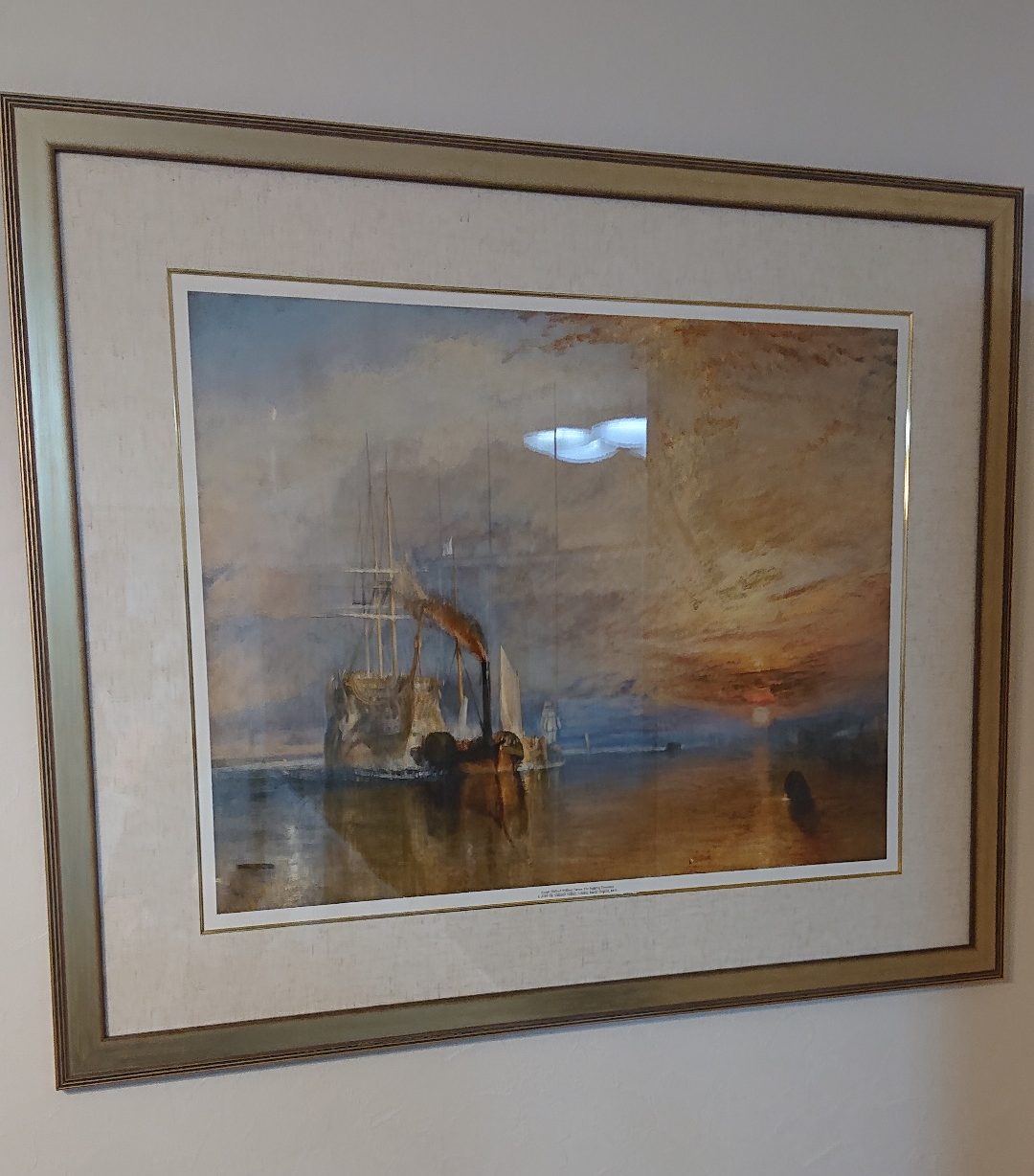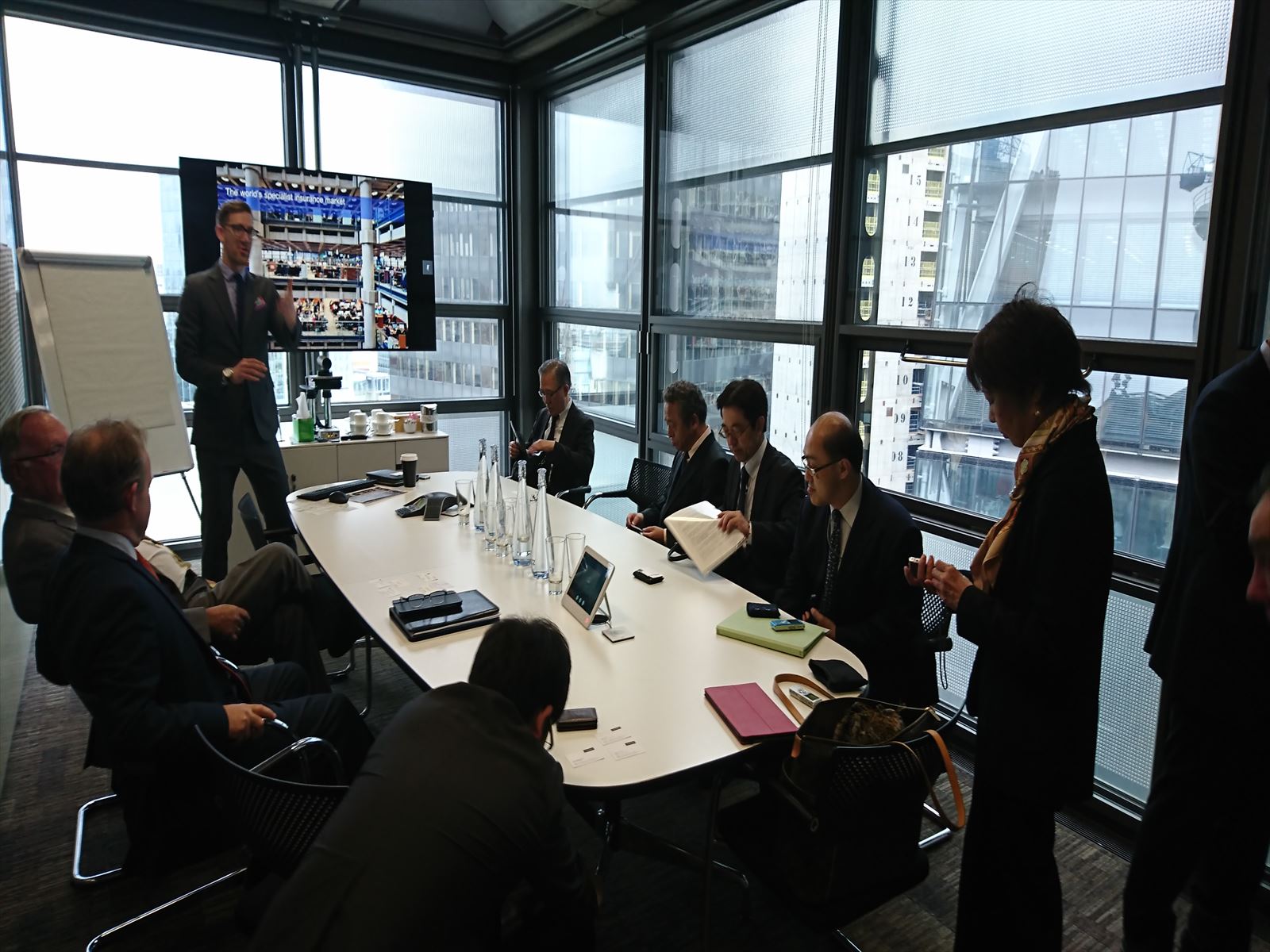リスク対応策 2020.03.23
RM29 ターナー(大変革時代)JMW Turner (A time of great change has arrived)
目次
Copyright © Shinichiro Hatani 2020 All rights reserved
For those who prefer to read this column in English, the Japanese text is followed by a British English translation, so please scroll down to the bottom of the Japanese text.
先月2月20日、英国の中央銀行である、イングランド銀行(Bank of England)から新しい20ポンド紙幣の流通が始まった。これまでの「経済学の父」と呼ばれるアダム・スミスに替わって肖像画に起用されたのは、「英国最高の画家」と評される、ロマン派の巨匠、ジョゼフ・M・W・ターナーである。●新しい20ポンド紙幣に関しては、イングランド銀行のYouTubeに詳述(英語版)
彼が描いた、ロンドンのナショナル・ギャラリー(国立美術館)にあるこの絵のタイトルは、「The Fighting Temeraire」である。日本語の定義では、「戦列艦」と訳すのが正確であるが、多くは「戦艦 テメレール」と訳されている。戦列艦とは「木造で非装甲の大砲を50門以上搭載した3本マストの帆船のこと」である。時代の経過とともに次第に大型化し、搭載門数が増えていったが、本格的な鉄製装甲艦が登場し、戦列艦に替わって海戦の主役になっていった。
トラファルガー海戦で勇名をはせた「戦列艦テメレール」も時代の流れに逆らえず、テムズ川を解体場へと引かれていく、静かな日没に美しく映える蒸気船のシルエットは、去りゆくものの気高さを示している、2005年に行われた英国国内の一般投票によって「最も偉大な英国絵画」に選ばれた、感動的な作品である。

咋年9月ロンドンに出張した際、ナショナル・ギャラリーで、「高精細複製画」を購入した。原寸サイズ:90.7x121.9cmに対して、ナショナル・ギャラリーの高精細キャンバスプリントの最大値、77.3x100cmのものである。
When I went on a business trip to London in September last year, I bought a “high definition reproduction” at the National Gallery. The original size is 90.7×121.9cm, while the maximum size of the National Gallery’s high definition canvas print is 77.3x100cm.
1.インターネットの登場
20年ほど前、財閥系生命保険会社の損保事業の経営コンサルタントを委嘱され、損保子会社のスタッフに、企業戦略、マーケティングそして海外の損害保険商品・事情に関して1997年、1年間講義をしたことがある。彼らと連絡を取ろうとしてEメールアドレスを聞いたが、「無いんです」との答えであった。その巨大な会社でさえ、インターネットを使ったEメール通信ができるパソコンは、システム部門のごく一部だけに置かれ、一般の職員がパソコンを使って通信できる範囲は「社内のみ」であった。社外とのEメール通信が可能になったのは、それから1年後のことであった。つまり、つい20年程前は、まだ「インターネット」という概念は一般的では無かったのである。
インターネットの歴史は1960年代のパケット通信の研究にその淵源があるが、1982年インターネット・プロトコル・スイート (TCP/IP)、つまり「インターネットおよびインターネットに接続する大多数の商用ネットワークで利用できる通信規約(通信プロトコル)一式)」 が標準化され、TCP/IPを採用したネットワーク群を世界規模で相互接続するインターネットという概念が提唱された。
この流れを大きく加速させたのが、1989年英国人のコンピューター技術者、ティム・バーナーズ・リーによって、いまでは当たり前のように使われている、WWW(World Wide Web)、URL(URI)、HTTP、HTML、これらが発明されたことによる。
このインターネットに、いま爆発的進化の時代が到来している。以前インターネットは、パソコンを使った通信手段であり、広範な携帯性には欠けていたが、携帯電話が「電話機」から「スマホ(スマートフォン)」に進化してく過程でその「電話機」の能力に急激な進化が見られ、送受信できるデータ量は飛躍的に増加したため、今では双方向電気通信でやり取りされる情報の98%以上がインターネット経由でやり取りされている。
2.産業構造の変革
2019年(平成31年)4月、経済産業省より発表された「第四次産業革命に向けた 産業構造の現状と課題について」という報告書のなかで;
近年の経営学では、既存企業のイノベーションを成功させるためには、新規事業と成熟事業を完全には分離させず、『知の深化』と『知の探索』をバランスよく推進する『両利きの経営』が重要と言われている」と述べられている。「知の深化」とは「大規模な成熟事業の推進」であり、「知の探索」とは「冒険的な新規事業の推進」であり、それらを「両利き」の状態に保つことであり、目先の利益に捉われた場合には、「成功の罠」に陥る。
よって、既存企業のイノベーションを成功させるためには、「既存事業の効率化と漸進型改善(知の深化)」と「新規事業の実験と行動(知の探索)」の両者を同時に行う「両利きの経営」が必要である
と述べられている。その理由としては、① 既存企業の事業運営は、事業が成熟するに伴い「深化」の実施に偏る傾向があること、②「探索」の実施には、「スピンアウト」ではなく、既存の組織能力と資産の活用が重要であることが挙げられているが、果たして米国流の経営学のとおりになるのであろうか。
3.日本の産業構造の変化
太平洋戦争の敗戦後、日本の産業は壊滅状態であった。そのなかで、石炭産業は日本の重要なエネルギー源として真っ先に復興が図られ、1950年代初頭までは、大学卒の優秀な学生はほとんどが石炭産業に就職するという人気業種であった。しかし、1960年代「石炭から石油へ」とエネルギー革命が起こると石炭産業は一気に斜陽産業となった。その代わり、日本の基幹産業としての役割を担ったのが、鉄鋼、造船産業であり、高度経済成長期の日本を牽引した。
しかし、1973年オイルショックが起きると、これら「重厚長大産業」は勢力を弱め、代わりに自動車、電化製品、コンピューターなどの産業が急成長して輸出品目の主役に躍り出た。一方、1980年代、重厚長大産業は、高付加価値製品に特化した戦略に向かい、2000年代になりようやく、長年停滞していた重厚長大産業も、中国経済の旺盛な設備投資により回復した。しかし、またもや、2008年のリーマンショックにより、今度は産業界全体が大きな打撃を受けた。
あれから10年を経ていま迎えようとしているのは、「ビッグデータ社会」である。その背景にあるモノが「IoT」である。IoTとは「Internet of Things」の頭文字を取った言葉であり、直訳して「モノのインターネット」と呼ばれている。
つまり、様々なモノがセンサーとしてインターネットに接続されるようになるということである。結果、学習データが豊富に集まるようになり、AI社会が到来しつつある。このように、インターネットは情報流通の面で、社会に非常に大きな変化を引き起こした。その影響は社会すべてに広がっている。そして、IoTの波はさらに広がって、ITデバイスや家電製品だけではなく、あらゆるモノがネットワークに接続される社会がやってくると考えられている。
以前、家電を買えば「説明書をみて設定をしていく」のが普通であったが、いまでは「まずインターネットの接続環境はいかがですか?」と家電が聞いてくる時代になったのである。
4.企業の「役割」の変化
以前、「お金を振り込む」という行為は、「銀行か郵便局に行って、振込依頼書に記入して窓口に出すこと」であった。しかし、コンビニエンス・ストアが続々とでき、各店舗にPOS(Point of Sale system:販売時点情報管理システム)レジが据え付けられると、通販商品等の払い込みは、銀行と郵便局に代わってコンビニエンス・ストアがその主役の座に躍り出た。
この動きは金融業界にも大きな影響を与えている。長く続く低金利のなかでビジネスモデルの変革が求められてきた銀行が、店舗の統廃合、人員の整理に着手しはじめているのである。銀行に行って振込をしようにも、既に「振込依頼書」は置かれておらず「振込の機械をお使いください」と案内される始末である。自動車産業もIoTの波を大きく被っている、「クルマの自動運転の主役」が巨大自動車メーカーからITの巨人、GAFA「Google, Amazon, Facebook, Apple」に移りつつあることが垣間見える。

2017年6月グローバル・リンクは、全国の市長、区長による地方自治の協議会である「全国市長会」から、「英国自治体における保険付保状況調査のコーディネイト依頼」を受け、「訪英総括コーディネイター」を委嘱され、ロンドンにおいて、ロイズ及びロイズ・シンジケートへの訪問、最高幹部との面談、またロンドン市並びに隣接都市の市役所への訪問、収入役他幹部との面談をおこなった。(上の写真は、ロイズのなかで、担当者よりロイズの説明を受けている時の一枚である)
In June 2017, Global Link was asked by the National Association of Mayors of Japan to co-ordinate a survey of insurance coverage in UK local authorities and was appointed as the overall co-ordinator for the visit. In London, we visited Lloyd’s of London and the Lloyd’s Syndicate and met with senior officials. We also visited the City Hall of London and adjoining cities and met with revenue officers and other senior officials. (The photo above shows them at Lloyd’s of London, where they were briefed on Lloyd’s of London by a representative.
その際、東日本大震災直後、2011年3月13日に感動的な「がんばれ日本 がんばれ東北」のメッセージを一面トップに掲載した英国の高級紙、「インデペンデント紙(The Independent)のことを話題に出せば」と思って調べてみると、なんと「2016年3月をもって廃刊、オンライン新聞に移行した」ということが判明した。
日本でも同様である、日本新聞協会の「日本の新聞発行部数」によると、2018年の部数は3990万部と2017年に比べて222万部減少した。14年連続の減少で、新聞発行部数のピークであった1997年の5376万部から21年間で、1386万部が減ったことになる。25%減、新聞発行部数が4分の3になった状況である。
今回のまとめ
産業構造の変化は、産業革命以来これまでも何度も起きてきたが、現在の変化ほど全産業に影響を及ぼす変革は無かったと言っても過言ではないだろう。
それほど、インターネットがすべての産業に密接に関わっているからである。インターネットの発展、進化が自社にとって「プラス面(機会)」に働くか、それとも「マイナス面(脅威)」になるか、いずれかによっては、企業戦略に甚大な影響を与え企業のビジネスモデルの変革さえ求める事態になる。
今般の新型コロナウイルスの蔓延による各国での対応を見ると、おしなべて「自宅から出ない、在宅勤務、リモート・ワーク、テレワーク」等の奨励である。「働く」ということは、「始業時間に出社、社員、職員が外出、また社内で集まって仕事をする、そして終業時間に退社」であった。これまで「なかなか変革できなかったこの仕事の形態」にも、大きな変化をもたらす機会が訪れた。また、食事のネット注文、オンライン問診、遠距離授業など、新型コロナウイルスの蔓延による「副作用」ですべての分野でデジタル化が確実に加速している。
企業の外部環境に「大変革」とも言える大きな変化が既に訪れている、キャプティブの設立を視野に入れた、本格的なリスクマネジメントが絶対に必要な時代になったと言えるのではないだろうか。
執筆・翻訳者:羽谷 信一郎
English translation
Risk Management 29 – JMW Turner (A time of great change has arrived)
On February 20th last month, the Bank of England, the UK’s central bank, began circulating a new £20 note. The Bank of England replaced Adam Smith, the father of economics, with a portrait of Joseph M.W. Turner, a master romanticist who is regarded as one of Britain’s greatest painters. For more on the new £20 note, see the Bank of England’s YouTube page.
The title of this painting he painted, in the National Gallery (National Gallery of Art) in London, is ”The Fighting Temeraire”. The Japanese definition is more accurately translated as “The Fighting Temeraire”, but many translate it as “The Battleship Temeraire”. A Fighting ship is “a wooden, three-masted sailing ship with more than 50 unarmored cannons”. As time went on, they gradually became larger and carried more guns, but full-blown iron armored ships appeared and replaced the battle lines as the mainstay of naval warfare.
The Temeraire, which gained fame at the Battle of Trafalgar, was also unable to resist the flow of time, and the silhouette of the steamer being pulled along the Thames to the dismantling place, showing the nobility of the departing ship, which was chosen as the “Greatest British Painting” by the public vote in Britain in 2005, a moving work of art.
When I visited London on a business trip in September last year, I bought a “High Definition Reproduction” at the National Gallery of Art. The original size is 90.7×121.9cm, while the maximum size of the National Gallery’s high-definition canvas print is 77.3x100cm.
1. The advent of the Internet
About 20 years ago, I was asked to be a management consultant for a P&C insurance business of a conglomerate life insurance company, and in 1997, I gave a year-long lecture to the staff of the P&C subsidiary on corporate strategy, marketing, and overseas P&C insurance products and conditions. When I tried to contact them, I asked for their e-mail address, but they said they did not have one. Even in this huge company, computers capable of communicating via the Internet were placed in only a few of the system departments, and ordinary employees could only communicate via computer “within the company”. It was only a year later that e-mail communication with the outside world became possible. In other words, just 20 years ago, the concept of “the Internet” was not yet common.
The history of the Internet can be traced back to the study of packet communications in the 1960s, but in 1982, the Internet Protocol Suite (TCP/IP), a set of communication protocols for the Internet and most commercial networks connected to the Internet, was standardized and the concept of a worldwide interconnected, TCP/IP-based network was proposed.
This trend was greatly accelerated by the invention of the World Wide Web (WWW), URLs (URIs), HTTP and HTML, all of which are now used in everyday life, by Tim Berners-Lee, a British computer engineer in 1989.
The Internet has now entered an era of explosive evolution. In the past, the Internet was a means of communication using personal computers and lacked widespread portability, but as mobile phones evolved from “telephones” to “smartphones,” the capabilities of the “phones” evolved rapidly and the amount of data that can be sent and received increased dramatically. More than 98% of the information exchanged via the Internet.
2. Industrial Structure Change
In a report titled “Current Status and Challenges of Industrial Structure Toward the Fourth Industrial Revolution” released by the Ministry of Economy, Trade and Industry in April 2019 ;
‘In recent years, management studies have emphasized the importance of “ambidextrous management”that does not completely separate new and mature businesses from each other, but rather promotes ‘deepening of knowledge’ and ‘search for knowledge’ in a balanced manner in order for existing companies to succeed in their innovation.
“Deepening knowledge” is “driving large mature businesses” and “exploring knowledge” is “driving adventurous new businesses” and keeping them “ambidextrous” and caught in the “success trap” when caught up in immediate profits.
Therefore, in order for innovation in existing companies to succeed, it is necessary to be ambidextrous, which means to improve the efficiency of existing businesses and to make incremental improvements (deepening of knowledge) and to experiment and act on new businesses (searching for knowledge) at the same time’.
The reasons for this are (1) existing companies tend to be biased towards implementing “deepening” as their businesses mature, and (2) the importance of leveraging existing organizational capabilities and assets rather than “spinning out” to implement “exploration,” but will it really follow the American way of management?
3. Changes in Japan’s Industrial Structure
After the defeat in the Pacific War, Japan’s industry was devastated. Until the early 1950s, the coal industry was a popular industry, with almost all outstanding university graduates finding employment in the industry. However, with the energy revolution of the 1960s, which saw a shift from coal to oil, the coal industry quickly declined. Instead, it was the steel and shipbuilding industries that played a key role in Japan’s core industries, driving the country’s rapid economic growth.
The 1973 oil crisis weakened the power of these “heavy and long industries” and were replaced by the automotive, electrical appliance, and computer industries, which grew rapidly and became the main exporters of Japanese goods. At the same time, in the 1980s, the heavy industry headed for a strategy of specializing in high value-added products, and in the 2000s the heavy industry, which had been stagnant for many years, finally recovered thanks to the Chinese economy’s vigorous capital investment. However, once again, the Lehman shock in 2008 dealt a major blow to the entire industrial world.
Now, 10 years later, what we are entering into is the “big data society”. Behind this is the IoT, an acronym for the Internet of Things, as it directly translates to “Internet of Things”.
In other words, it means that various objects will be connected to the Internet as sensors. As a result, an abundance of learning data is being gathered, and the AI society is on its way. In this way, the Internet has caused a very big change in society in terms of information distribution. Its impact is spreading to all of society. And the wave of IoT is expected to spread further, leading to a society in which not only IT devices and home appliances, but all kinds of things will be connected to the network.
In the past, when you bought a home appliance, it was normal to read the manual and set up the settings, but nowadays, people ask, “How is the Internet connection environment? “The time has come for consumer electronics to ask.
4. The changing role of companies
In the past, making a transfer of money was simply a matter of going to a bank or post office, filling out a transfer request form, and presenting it at the counter. However, as more and more convenience stores were built and point-of-sale systems (POS) cash registers were installed at each store, convenience stores replaced banks and post offices as the mainstay of payment methods for mail-order products etc.
This move has had a major impact on the financial industry. Banks, which have been forced to change their business models in the face of prolonged low interest rates, have begun to consolidate and reduce their staffing levels.
When you go to a bank to make a transfer, as there was no money transfer request and you are directed to “use the transfer machine”. The automotive industry is also suffering greatly from the wave of IoT, and there are glimpses that the “leading role in the self-driving of cars” is shifting from the giant automakers to the IT giants, GAFA “Google, Amazon, Facebook, Apple”.
In June 2017, Global Link was asked by the National Conference of Mayors, a local government council of mayors and borough mayors, to coordinate a survey of insurance coverage in the UK, and was appointed as the General Co-ordinator of the visit. In London, we visited Lloyd’s of London and Lloyd’s Syndicate, met with top management, visited the City of London and adjoining city halls, and met with revenue officers and other executives.
I thought it would be a good idea to mention The Independent, the British newspaper that ran a moving message on the front page on March 13, 2011, just after the Great East Japan Earthquake, saying “Ganbare Japan, Ganbare Tohoku”. And to my surprise, it turned out that it had ceased publication in March 2016 and had moved to an online newspaper.
The same is true in Japan. According to the Japan Newspaper Publishers and Editors Association’s “Newspaper Circulation in Japan,” circulation in 2018 was 39.9 million, down 2.22 million from 2017, a 14-year decline, representing a decrease of 13.86 million in 21 years from the peak of newspaper circulation of 53.76 million in 1997. This represents a 25% decline in circulation and a three-fourth reduction in the number of newspapers published.
Summary of this issue
Changes in the structure of industry have occurred many times since the industrial revolution, but it would be no exaggeration to say that there has never been a change that has affected all industries as much as the current change.
This is because the Internet is so intimately connected to all industries. Depending on whether the development and evolution of the Internet is an opportunity or a threat, it could have a profound impact on corporate strategies and even require companies to change their business models.
The response to the recent outbreak of the new coronavirus in many countries has been to encourage people to stay home, work from home, work remotely and telework. “Working” meant “arriving at work at the beginning of the day, having employees and staff go out of the office, or gathering together in the office to work, and leaving at the end of the day”. The opportunity arose to bring about major changes to this form of work that had been “difficult to change” in the past. In addition, the “side effects” of the spread of the new coronavirus, such as online ordering of meals, online medical interviews, and long-distance classes, have steadily accelerated digitalization in all areas.
A major change, a “sea change” in the external environment of companies is already coming, and with an eye on the establishment of captives, we can say that full-scale risk management is absolutely necessary.
Author/translator: Shinichiro Hatani

